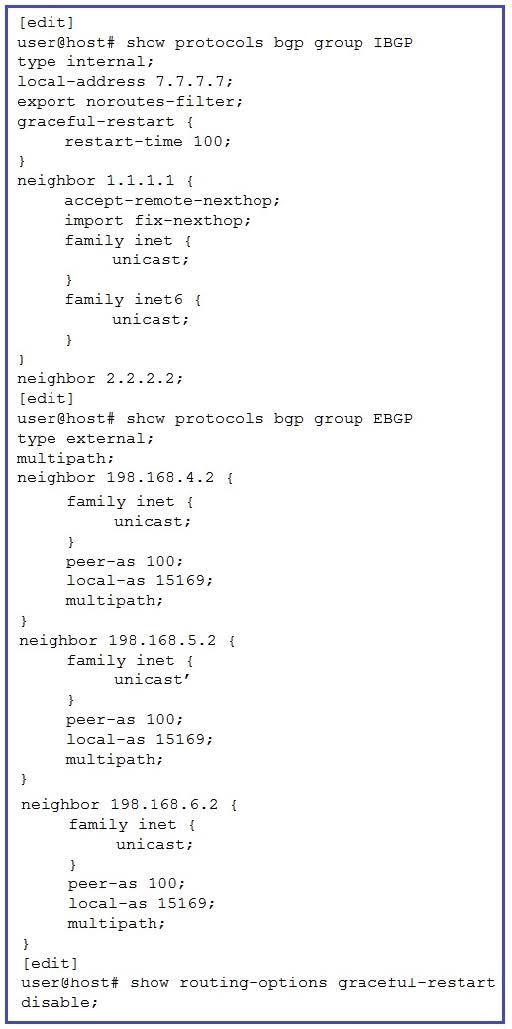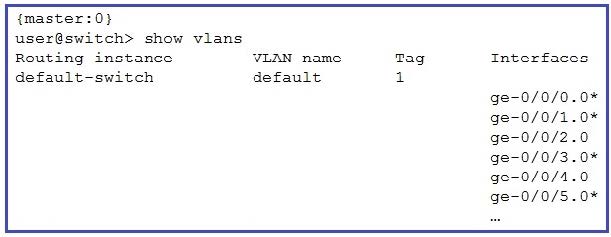Exam Details
Exam Code
:JN0-351Exam Name
:Enterprise Routing and Switching, Specialist (JNCIS-ENT)Certification
:Juniper CertificationsVendor
:JuniperTotal Questions
:175 Q&AsLast Updated
:Mar 28, 2025
Juniper Juniper Certifications JN0-351 Questions & Answers
-
Question 71:
What is a characteristic of OSPF ASBRs?
A. ASBRs transmit routing information between the backbone and other areas.
B. ASBRs cannot be part of the backbone and another area at the same time.
C. ASBRs inject routing information from outside the OSPF domain.
D. ASBRs link two OSPF areas.
-
Question 72:
Given the exhibit, which two statements are correct regarding the graceful-restart state for the BGP groups? (Choose two.)

A. The graceful-restart capability will be enabled for group IBGP.
B. The graceful-restart capability will be disabled for group IBGP.
C. The graceful-restart capability will be disabled for group EBGP.
D. The graceful-restart capability will be enabled for group EBGP.
-
Question 73:
Which statement is true about IP-IP tunnels?
A. The time-to-live value of the original packet Is decremented.
B. IP-IP tunnels are protocol agnostic.
C. The packet is encapsulated unchanged before entering the tunnel
D. The packet header is replaced before entering the tunnel
-
Question 74:
You are concerned that someone from outside the company could use an open conference room port to access the network.
Which feature should you use to address this concern?
A. persistent MAC learning
B. 802.1X
C. DHCP snooping
D. MAC limiting
-
Question 75:
Your BGP router receives routes from two upstream ISPs: ISP A and ISP B. In this scenario, which change would you make to prefer routes from ISP A?
A. Set the local-preference attribute for all routes received from ISP A to 200 while all routes received from ISP B use the default local-preference value of 100.
B. Prepend the AS path to all routes received from ISP A while all routes received from ISP B use the default AS path value.
C. Change the MED value for all routes received from ISP A to 1 while all routes from ISP B remain configured with no MED value.
D. Set the local-preference attribute for all routes received from ISP A to 50 while all routes received from ISP B use the default local-preference value of 100.
-
Question 76:
Click the Exhibit button.

Referring to the exhibit, what does the asterisk(*) following the ge-0/0/5.0 interface indicate?
A. It indicates the interface is not active.
B. It indicates the interface is a trunk port.
C. It indicates the interface is an access port.
D. It indicates the interface is active.
-
Question 77:
What are three requirements to ensure proper GRE or IP-IP tunnel routing? (Choose three.)
A. Keepalives must be used on stateless tunneling protocols.
B. Tunnel endpoints must have a route that directs traffic into the tunnel.
C. BGP must be used on intermediate devices.
D. Tunnel endpoints must have a valid route to the remote endpoint.
E. All intermediary devices must have a route to the tunnel endpoints.
-
Question 78:
Which two statements about a unified ISSU are correct? (Choose two.)
A. It requires that Bidirectional Forwarding Detection be disabled.
B. It requires that graceful Routing Engine switchover be enabled.
C. It is only supported on platforms with redundant control planes.
D. It is only supported on platforms with redundant power supplies.
-
Question 79:
Which mechanism is used to share routes between routing tables?
A. RIB groups
B. routing instances
C. forwarding instances
D. filter-based forwarding
-
Question 80:
Click the Exhibit button.

You are building a network and make some configuration changes. While trying to validate these changes, you receive the error shown in the exhibit.
How would you solve this problem?
A. You must create a new VLAN called all using the VLAN ID of 30.
B. You must configure the ge-0/0/5.0 interface with family inet instead of family ethernet- switching.
C. You must configure the port mode as trunk on the ge-0/0/5.0 interface.
D. You must create two sub-interfaces on ge-0/0/5 with the appropriate VLAN member assigned to each.
Related Exams:
JN0-102
Internet Associate, Junos(JNCIA-Junos)JN0-104
Junos, Associate (JNCIA-Junos)JN0-105
Junos, Associate (JNCIA-Junos)JN0-1101
Juniper Networks Certified Design Associate (JNCDA)JN0-130
Juniper networks Certified internet specialist.e(jncis-e)JN0-1301
Data Center Design, Specialist (JNCDS-DC)JN0-1302
Data Center Design Specialist (JNCDS-DC)JN0-1331
Security Design, Specialist (JNCDS-SEC)JN0-1332
Security Design, Specialist (JNCDS-SEC)JN0-1361
Service Provider Design Specialist (JNCDS-SP)
Tips on How to Prepare for the Exams
Nowadays, the certification exams become more and more important and required by more and more enterprises when applying for a job. But how to prepare for the exam effectively? How to prepare for the exam in a short time with less efforts? How to get a ideal result and how to find the most reliable resources? Here on Vcedump.com, you will find all the answers. Vcedump.com provide not only Juniper exam questions, answers and explanations but also complete assistance on your exam preparation and certification application. If you are confused on your JN0-351 exam preparations and Juniper certification application, do not hesitate to visit our Vcedump.com to find your solutions here.